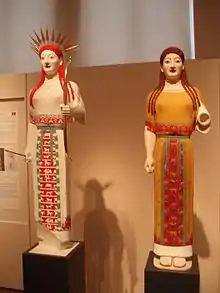Peplos Kore
The Peplos Kore is a statue of a girl and one of the most well-known examples of Archaic Greek art. The 118 cm-high (46 in) high white marble statue was made around 530 BC and originally was colourfully painted.[1] The statue was found, in three pieces, in an 1886 excavation north-west of the Erechtheion on the Athenian Acropolis and is now in the Acropolis Museum in Athens.[2]


The Peplos Kore (peplos being the type of robe or shawl-like fabric draped over the figure and kore meaning a girl or young female) stands at approximately 1.18 m (3 ft 10 in) high. It is carved from fine grained Parian marble.[3] Traces remain of the original paint.
Description
The name of the statue comes from the heavy woolen garment worn by the girl (Greek: κόρη, kore), the Dorian peplos, which was no longer actually in fashion when the marble statue was made. Underneath it, the girl wears a thin chiton which peeps out from the sleeves and hem.[4] Bore holes on the head and shoulders indicate that the statue was decorated with bronze head decorations (probably a wreath) and shoulder fibulae. The left arm was made of a separate piece of stone and is now lost.
The Peplos Kore is ascribed to the Rampin Master who is named for another head, very similar in style, which was in the Rampin Collection and is now on display in the Louvre.
In Brinkmann's opinion, this statue type does not depict mortal girls but goddesses.[5] Her posture does not correspond to that of a typical late archaic kore, "who steps forward with her left leg, holds her skirt with her left hand and holds fruit in the crook of her right arm".[6] The Peplos Kore, has 35 bore holes in two rows around her head and one bore hole in her right hand which suggests she may have worn a rayed crown or a helmet and held attributes such as a bow and arrows or a shield.[7] The reconstructions of the Peplos Kore displayed in the Gods in Colour exhibition, for example, illustrate such possibilities.[8]
A number of other similar kore statues (plural korai) have been discovered at the Acropolis, dating to as early as the early 6th century BCE. Some scholars have suggested that those kore statues were commissioned as offerings to worshiped deities, perhaps as votive figures who stand in the place of a patron. Korai also appear in Attic cemeteries as grave markers for deceased women, as was the case for the Phrasikleia Kore. But the Peplos Kore has distinct differences from the other discovered kore figures; the work is dressed in a particular manner, leading some archaeologists to suggest that the statue was a depiction of a goddess, or even a sculpted depiction of a wooden cult statue.[9]
The statue is carved in the round, but designed to be seen from the front, with many details, especially in the facial features. The face displays an “archaic smile” similar to many Greek statues from the Archaic period. The kore statues depict young, clothed female figures, in contrast to their male counterparts, the kouros figures which are presented as muscular nude males.[10]
In 1975, the Museum of Classical Archaeology, Cambridge attempted to replicate the sculpture’s original appearance by painting a cast of the figure.[11] The replica was then displayed next to a second, unpainted cast to demonstrate the difference between the pure white marble that is commonly associated with Greek sculpture and the brightly-painted version that is probably closer to reality.[3] Two further alternative polychromed versions were shown together in the touring Gods in Colour exhibition.
See also
References
- Richard Neer (22 October 2010). The Emergence of the Classical Style in Greek Sculpture. University of Chicago Press. pp. 119–. ISBN 978-0-226-57065-5.
- Ridgway, Brunilde Sismondo (1977). "The Peplos Kore, Akropolis 679". The Journal of the Walters Art Gallery. 36: 46–61. JSTOR 20168947.
- "Peplos Kore". Faculty of Classics. University of Cambridge. Retrieved 25 September 2015.
- Mary Stieber (1 January 2010). The Poetics of Appearance in the Attic Korai. University of Texas Press. pp. 25–. ISBN 978-0-292-77349-3.
- Vinzenz Brinkmann, Mädchen oder Göttin? Das Rätsel der ›Peploskore‹ von der Athener Akropolis, in Vinzenz Brinkmann and Raimund Wünsche (Ed.), Bunte Götter. Die Farbigkeit antiker Skulptur, Staatliche Antikensammlungen and Glyptothek, München 2003, pp. 53–60.
- Brinkmann 2003, p. 56
- Ridgway, Brunilde Sismondo (1977). "The Peplos Kore, Akropolis 679". The Journal of the Walters Art Gallery. 36: 49–61. ISSN 0083-7156.
- Crowned female statue with bow and arrows
- Ridgway, Brunilde Sismondo (1977). "The Peplos Kore, Akropolis 679". The Journal of the Walters Art Gallery. 36: 49–61. ISSN 0083-7156.
- "Kore / Korai". Ancient-Greece.org. © 2002- 2015 Ancient-Greece.org. Retrieved 20 September 2015.
- photo
Further reading
- John Boardman. Griechische Plastik. Die archaische Zeit. Zabern, Mainz 1991, ISBN 3-8053-0346-7, p. 78, Tbl 115 and 129.
- Katerina Karakasi. Archaische Koren. Hirmer, München 2001, ISBN 3-7774-8840-2
- Brunhilde Sismondo Ridgway. "The Peplos Kore, Acropolis 679" Journal of the Walters Art Gallery, 36, 1977, pp. 49–61, ISSN 0083-7156.
External links
| Wikimedia Commons has media related to Peplos Kore. |
- Statue of a Kore, "Peplos Kore" in the archaeological database Arachne (in German)
- Detailed informationen (in German)
- Earlier reconstruction attempt, University of Cambridge
- Colour reconstruction, Brinkmann's variant A (in Spanish)
- Stiftung Archäologie, Color reconstruction, Brinkmann's variant C